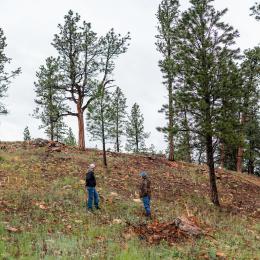After the Fire - Hydromulching
Hydromulching is spraying a mixture of water, fiber mulch, and tackifier on burned slopes to prevent soil erosion or foster revegetation. Seed, fertilizer, or soil stabilizing polymers may also be applied with the hydromulch.
When is hydromulching used?
Hydromulch is used on severely burned or otherwise highly erosive areas with 20 percent to 60 percent slopes. Hydromulching is an expensive erosion control method and therefore is generally limited to treating high risk areas to protect valuable properties, surface water supply sources, or important habitat. Due to its expense, conventional mulching is generally used on slopes less than 20 percent. Use of ground applied hydromulch is limited to areas within 300 feet of the roads or trails that are necessary to provide access for the application equipment.
Uniform aerial application of hydromulch is difficult to accomplish and as a result has proven less effective for erosion control, so it is seldom recommended. Hydromulch is generally not recommended where there is more than 25 percent surface rock cover, in areas where there is appreciable needle-cast, or where there is good potential for regrowth of vegetation within the first year after a fire.
Methods and materials
Hydromulching utilizes a 1,000 to 3,000 gallon tank mounted on a truck or trailer that is equipped with a special pump and continuous agitation system. The pump forces the slurry through either a discharge nozzle mounted on top of the tank or a nozzle on the end of a hose. Hoses are typically limited to 200 feet in length. Fiber mulch and tackifier are added to the water in the tank and thoroughly mixed prior to application.
The type and amount of mulch and tackifier is selected to provide a minimum of 70 percent surface cover that will remain in place for at least one growing season. Application rates in the range of 2,000 to 3,000 pounds of wood fiber mulch and 75 to 100 pounds of Guar based tackifier per acre are typical. Fiber mulch has natural tackifying properties, but adding a tackifier is necessary to ensure the mulch remains in place when it is applied to burned slopes. Use of 500 to 1,000 pounds fiber mulch per acre and tackifier can be applied over loose, blown straw to tack it down where crimping is impractical.
The actual materials and application rates to be used at any location should be determined by erosion control experts with consideration for the specific site characteristics and the level of protection required.
Hydroseeding
When seed is applied with the mulch (Hydroseeding) split applications are generally more effective than applying all materials in one pass. About 500 pounds of mulch per acre is applied with the seed (and fertilizer if recommended) in the first pass followed by a second application of 1,500 to 2,000 pounds of mulch and tackifier. See the Temporary and Permanent Seeding Fact Sheets for specific seed recommendations.
Safety concerns
Ground hydromulching uses existing roads that may have other traffic. A road safety plan is needed to identify and explain how to mitigate traffic related hazards.
Personnel applying hydromulch must wear the type and extent of personal protective equipment that is appropriate for the type and nature of material being applied.
Fiber mulch is dyed to aid in uniform distribution, and care should be taken to avoid application on concrete, painted surfaces, or other structures/areas where mulch is not intended to be applied.

"CAUTION: After a fire, many trees are weakened from burning around the base of the trunk. These trees can fall over or blow down without warning. Shallow-rooted trees can also fall. Therefore, be extremely alert around burned trees.
Additional Information
Montana Forestry Resources
NRCS Montana guides for forest management and wildfire recovery.
NRCS Forestry Web Page
Forestry and agroforestry information and technical resources that apply to all States.

